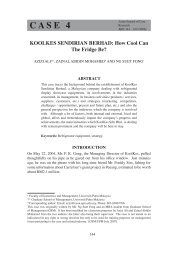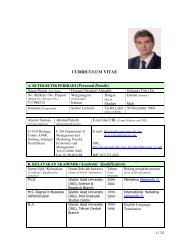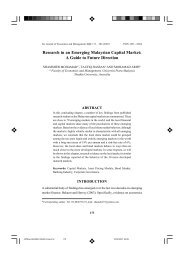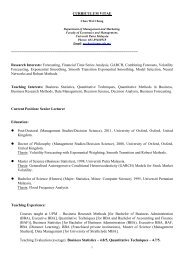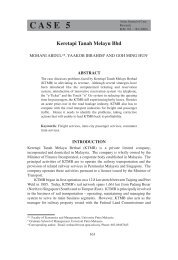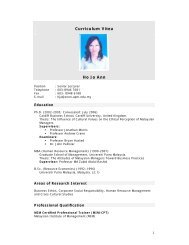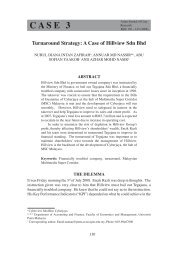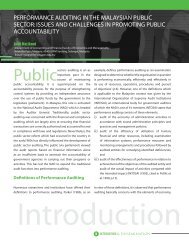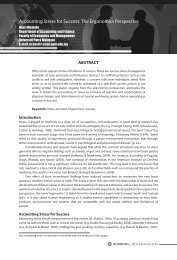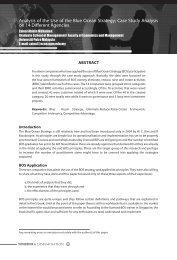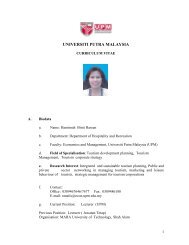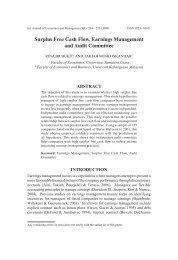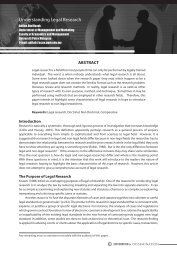The Transmission Mechanism and the Channels of Monetary Policy
The Transmission Mechanism and the Channels of Monetary Policy
The Transmission Mechanism and the Channels of Monetary Policy
- No tags were found...
Create successful ePaper yourself
Turn your PDF publications into a flip-book with our unique Google optimized e-Paper software.
@ Free Notes by Dr. Azali Mohamed 33.2.1 <strong>The</strong> Money View<strong>The</strong> money view places emphasis on <strong>the</strong> changes in <strong>the</strong> monetary aggregate affecting <strong>the</strong>output via interest rate channel. This view has been a st<strong>and</strong>ard feature in <strong>the</strong> traditionalKeynesian model. <strong>The</strong> mechanism can be traced by using <strong>the</strong> following schematic diagram(Mishkin, 1995):Mfl r› Ifl Yfl ,This diagram states that a contractionary monetary policy (M) leads to a rise in real interestrate (r), which raises <strong>the</strong> cost <strong>of</strong> capital, <strong>the</strong>reby causing a decline in investment goods (I).Fur<strong>the</strong>r, this leads to a decline in aggregate dem<strong>and</strong> <strong>and</strong> hence, a fall in output (Y).Generally, this argument can be presented in a simple IS-LM framework. <strong>The</strong> frameworkfocuses on <strong>the</strong> equilibrium position between <strong>the</strong> dem<strong>and</strong> for <strong>and</strong> supply <strong>of</strong> money todetermine <strong>the</strong> rate <strong>of</strong> interest. This in turn provides <strong>the</strong> link to real spending <strong>and</strong> investment.Let <strong>the</strong> monetary equilibrium <strong>and</strong> <strong>the</strong> LM curve be depicted by equations (3.1) - (3.3),respectively 3 ;money dem<strong>and</strong> M d = f (y,r); f 1 ’>0, f 2 ’
@ Free Notes by Dr. Azali Mohamed 5From (3.9) a change in <strong>the</strong> money supply clearly affects <strong>the</strong> level <strong>of</strong> income through <strong>the</strong>parameters a 1 , a 2 , b 1 , f 1 , <strong>and</strong> f 2 which are all slopes <strong>of</strong> <strong>the</strong> IS-LM curves. Thus, we canhave <strong>the</strong> money multiplier in <strong>the</strong> form <strong>of</strong> <strong>the</strong> coefficient on ∆M:(3.10)1∆ y =∆ M⎛ a1 f⎜ 2 ⎞⎟ + f⎝ b − 11 a2⎠Based on equation (3.10) it is clear that <strong>the</strong> interest rate channel or <strong>the</strong> cost <strong>of</strong> capitalchannel operates through <strong>the</strong> following schematic diagram:f 2 : ( ∆M ⇒ ∆r), b 1 :(∆r ⇒ ∆I) <strong>and</strong> a 1 :(∆I ⇒ ∆y) with f 1 :(∆y ⇒ ∆M d ) acting as afeedback effect.Considering <strong>the</strong> money view, obviously <strong>the</strong>re are two implicit assumptions in <strong>the</strong> model. <strong>The</strong>first is that all non-money assets are lumped toge<strong>the</strong>r into bonds. <strong>The</strong>refore, by usingWalrasian Law <strong>the</strong> bond market is in equilibrium, implying that <strong>the</strong> credit market is largelyignored in <strong>the</strong> st<strong>and</strong>ard IS-LM model <strong>and</strong> is restricted to a single portfolio equation(Brunner <strong>and</strong> Meltzer, 1988). <strong>The</strong>re are two implications that can be drawn from thisassumption. First, it makes no difference whe<strong>the</strong>r banks hold loans or governmentsecurities as <strong>the</strong>ir assets. Second, it makes no difference whe<strong>the</strong>r borrowers obtain creditfrom auction markets (<strong>the</strong> commercial paper market <strong>and</strong> <strong>the</strong> corporate bond market) orfrom <strong>the</strong> banks (Yang, 1994).
@ Free Notes by Dr. Azali Mohamed 6<strong>The</strong> second assumption <strong>of</strong> <strong>the</strong> money view is that all markets are perfect. All <strong>of</strong> <strong>the</strong>borrowers are homogenous from <strong>the</strong> view point <strong>of</strong> <strong>the</strong> lenders. Thus, <strong>the</strong> banks cannotdiscriminate between <strong>the</strong> characteristics <strong>of</strong> different borrowers. Hence, price is <strong>the</strong> onlyfactor to clear <strong>the</strong> markets or to equilibrate <strong>the</strong> markets. Consequently, <strong>the</strong> presence <strong>of</strong>endogenous credit rationing is also ruled out by <strong>the</strong> second assumption (Bernanke <strong>and</strong>Blinder, 1988).3.2.2 <strong>The</strong> Credit View<strong>The</strong> proponents <strong>of</strong> <strong>the</strong> credit view claim that <strong>the</strong> credit market has been simply ignored by<strong>the</strong> money view. <strong>The</strong>refore, in addition to <strong>the</strong> money supply, bank credit is also important inaffecting <strong>the</strong> aggregate spending level. Bernanke <strong>and</strong> Gertler (1995) describe two possiblelinkages <strong>of</strong> <strong>the</strong> credit channel <strong>the</strong>ory. <strong>The</strong> first one is <strong>the</strong> balance-sheet channel which placesemphasis on <strong>the</strong> impact <strong>of</strong> changes in monetary policy on <strong>the</strong> borrower's balance-sheet.<strong>The</strong> second linkage is <strong>the</strong> bank lending channel which focuses on <strong>the</strong> possible effect <strong>of</strong>monetary policy actions on <strong>the</strong> supply <strong>of</strong> loans by <strong>the</strong> banking system (Walsh <strong>and</strong> Wilcox,1995; Bernanke, 1993a <strong>and</strong> 1993b).Schematically, <strong>the</strong> monetary policy effects can be summarised as follows:M fl bank deposit fl bank loans fl I fl Y fl ,Thus, contractionary monetary policy leads to a fall in bank reserves <strong>and</strong> bank deposits,subsequently this results in a decline in bank loans, in turn leading to a decline in investmentspending <strong>and</strong> a fall in output.
@ Free Notes by Dr. Azali Mohamed 7To facilitate <strong>the</strong> schematic diagram above, let us consider a variant <strong>of</strong> <strong>the</strong> IS-LM model,based on <strong>the</strong> framework set out by Bernanke <strong>and</strong> Blinder (1988). <strong>The</strong>ir model allows rolesfor both “credit” (bank loans) <strong>and</strong> money ra<strong>the</strong>r than money-only as in <strong>the</strong> traditional IS-LM framework. An explicit assumption made regarding this model is that loans <strong>and</strong> o<strong>the</strong>rauction-market credit (“bonds”) are viewed as imperfect substitutes, hence, allowing <strong>the</strong>model to include <strong>the</strong> credit <strong>and</strong> bonds market in addition to <strong>the</strong> money market 4 . By doingso, <strong>the</strong> borrowers <strong>and</strong> lenders may choose between bonds <strong>and</strong> loans according to <strong>the</strong>interest rates on <strong>the</strong> two credit instruments. By setting up this particular assumption, <strong>the</strong> LMcurve is <strong>the</strong>n derived from a set <strong>of</strong> portfolio-balance conditions on <strong>the</strong> two-asset world:money <strong>and</strong> credit (“bonds”). To derive <strong>the</strong> credit curve or “commodities <strong>and</strong> credit” (CC)curve, first, let <strong>the</strong> dem<strong>and</strong> for loans be:- + +dL = L i y( ρ , , )(3.11)where ρ is <strong>the</strong> interest rate on loans, i is <strong>the</strong> interest rate on bonds, y is <strong>the</strong> income tocapture <strong>the</strong> transactional dem<strong>and</strong> for credit, <strong>and</strong> <strong>the</strong> signs indicate <strong>the</strong> relationship <strong>of</strong> eachvariable with respect to <strong>the</strong> loans dem<strong>and</strong>. Second, <strong>the</strong> loan supply function is derived froma simplified bank balance sheet as follows:assetsreserves (R)bonds (B b )loans (L s )liabilitiesdeposits (D)4 Karl Brunner <strong>and</strong> Allan Meltzer (1972, 1988) also develop similar models. An application on <strong>the</strong> UKdata using a variant <strong>of</strong> <strong>the</strong> Brunner <strong>and</strong> Meltzer model can be found in Kent Mat<strong>the</strong>ws <strong>and</strong> ChrisIoannidis (1992).
@ Free Notes by Dr. Azali Mohamed 8where R= σD + E; σ is <strong>the</strong> required reserves ratio, <strong>and</strong> E is <strong>the</strong> excess reserves. Thus<strong>the</strong> bank’s adding-up constraint is: B b + L s + E = D (1-σ ). <strong>The</strong>refore <strong>the</strong> loans supplyfunction is as follows:+ī σ (3.12)sL = l(r, ) D(1 - )with a similar equation for B b <strong>and</strong> E. <strong>The</strong> clearing condition for <strong>the</strong> loan market is:L d = L s (3.13)L( ρ ,i, y) = λ( ρ,i) D(1 - σ)(3.14)<strong>The</strong> money market is described by a conventional LM curve. Banks hold excess reservesequal to ε(i)D(1 - σ). <strong>The</strong> supply <strong>of</strong> deposits is equal to bank reserves, R, times <strong>the</strong>money multiplierm = m(i).R; (3.15)where m(i) = [1/ε(1-σ)+σ] 5 .<strong>The</strong> dem<strong>and</strong> for deposits isD d += D( i, y)(3.16)By using equations (3.15) <strong>and</strong> (3.16), (D = m(i)R) to replace D on <strong>the</strong> right side <strong>of</strong> <strong>the</strong>equation (3.14), we haveL = λ[ ρ, i] m( i) R( 1 - ρ)(3.17)
@ Free Notes by Dr. Azali Mohamed 9Taking <strong>the</strong> total differentiation on (3.17)withdL = λ R( 1- σ) midi + m( i) R( 1- σ)( λρdρ + λ idi) + λm( 1-σ)dR (3.18)m i > 0 ; λ ρ > 0; λ i > 0.Next, using total differentiation to solve <strong>the</strong> left h<strong>and</strong> side <strong>of</strong> equation (3.14), we havedL = Lρdρ + Lidi + Lydy(3.19)withL ρ < 0;L i > 0;L y > 0.Equating equations (3.18) <strong>and</strong> (3.19), <strong>the</strong>n rearranging to solve for ρ as a function <strong>of</strong> i, y,<strong>and</strong> R; we have 6Lρ- m( i) R( 1- σ) λ ρ) dρ = λR( 1- σ) mi + m( i) R( 1- σ) λi - Li) di + (-Ly)dy+ mλm( 1 - σ)dR(3.20)Thus, <strong>the</strong> loan rate that clears <strong>the</strong> loan market can be stated as follows:ρ =+ + -Φ( i, y, R )(3.21)5 −Is solved as follows: m ≡ D / ( E + RR ) ; ∴m ≡ D / [ ε( D)( 1 − σ) + σD];∴ m( i) = [ ε( i)( 1− σ) + σ) ] 16 To get equation (4) <strong>of</strong> Bernanke <strong>and</strong> Blinder (1988;p.436).
@ Free Notes by Dr. Azali Mohamed 10Equation (3.21) shows that <strong>the</strong> interest rate on loans is positively related to interest rateon bonds <strong>and</strong> income, but inversely related to bank reserves. To solve for <strong>the</strong> aggregatedem<strong>and</strong> curve, Bernanke <strong>and</strong> Blinder (1988) use <strong>the</strong> following generic IS curve:y= Y( i, ρ )(3.22)<strong>and</strong> <strong>the</strong>n by substituting equation (3.21) into (3.22), we gety = Y( i, Φ { i, y, R}),(3.23)<strong>the</strong> so-called “commodities <strong>and</strong> credit” (CC) curve in Bernanke <strong>and</strong> Blinder’s term. Figure3.1 shows both <strong>the</strong> CC <strong>and</strong> LM curves in a (i,y) space.iLMCCFigure 3.1 <strong>The</strong> Commodities-Credit (CC) <strong>and</strong> LM CurvesY
@ Free Notes by Dr. Azali Mohamed 11As discussed by Bernanke <strong>and</strong> Blinder (1988; p. 436), <strong>the</strong> CC curve 7 is negativelysloped like an IS curve but it is shifted by monetary policy 8 , R, <strong>and</strong> by credit shock thataffects ei<strong>the</strong>r <strong>the</strong> loans dem<strong>and</strong> function, L(.) or <strong>the</strong> loans supply function, λ(.).<strong>The</strong>re is one disadvantage if one wants to apply this framework in a developing country'scontext. <strong>The</strong> model assumes that <strong>the</strong> loan market is always in equilibrium. This scenariomay not be true in <strong>the</strong> context <strong>of</strong> developing countries simply due to heavy governmentintervention in <strong>the</strong> loan market during <strong>the</strong> pre-liberalisation period i.e. interest-rate ceilings<strong>and</strong> quantitative credit controls. Thus, it could be possible for <strong>the</strong> transmission mechanismprocess to exist through <strong>the</strong> credit rationing channel. Fur<strong>the</strong>r discussion on <strong>the</strong> creditrationing channel is presented in Section 3.4.7 <strong>The</strong> CC curve reduces to <strong>the</strong> IS curve if loans <strong>and</strong> bonds are assumed to be perfect substitutes ei<strong>the</strong>rto borrowers (Lρ →-∞) or to lenders (λρ→∞) or if commodity dem<strong>and</strong> is insensitive to <strong>the</strong> loan rate(Yρ=0). (Ibid; p. 436)8 Graphically, <strong>the</strong> ambiguity arises because an increase in R shifts both <strong>the</strong> CC <strong>and</strong> LM curves outward.Economically, <strong>the</strong> credit channel makes monetary policy more expansionary than <strong>the</strong> IS/LM <strong>and</strong><strong>the</strong>refore raises <strong>the</strong> transaction dem<strong>and</strong> for money by more than in <strong>the</strong> conventional model. (Ibid; p.437).
@ Free Notes by Dr. Azali Mohamed 123.3 <strong>The</strong> Development <strong>of</strong>, <strong>and</strong> Empirical Evidence Relating To <strong>the</strong> Credit <strong>and</strong><strong>the</strong> Money <strong>Channels</strong>A summary <strong>of</strong> <strong>the</strong> empirical findings <strong>of</strong> <strong>the</strong> previous studies conducted in this area ispresented in Tables 3.1 <strong>and</strong> 3.2. Tables 3.1 summarises <strong>the</strong> empirical evidence from <strong>the</strong>developed countries, while Table 3.2 highlights <strong>the</strong> empirical evidence from <strong>the</strong> developingcountries. Empirical evidence from <strong>the</strong> developed countries available so far has providedsome support to <strong>the</strong> credit as well as <strong>the</strong> money channels hypo<strong>the</strong>sis. However, <strong>the</strong>evidence for <strong>the</strong> developing countries is somewhat blurred.3.3.1 Evidence from <strong>the</strong> Industrialised CountriesTable 3.1 summarises <strong>the</strong> empirical evidence using <strong>the</strong> data set on most <strong>of</strong> <strong>the</strong> industrialisedcountries. Interestingly, most <strong>of</strong> <strong>the</strong>se studies support <strong>the</strong> importance <strong>of</strong> <strong>the</strong> money as wellas <strong>the</strong> credit/bank lending channel in <strong>the</strong> transmission mechanism process (Bernanke (1986);Bernanke <strong>and</strong> Blinder (1988); Bernanke <strong>and</strong> Blinder (1992); Kashyap, Stein, <strong>and</strong> Wilcox(1993); Walsh <strong>and</strong> Wilcox (1995); <strong>and</strong> Oliner <strong>and</strong> Rudebush (1995)); amongst o<strong>the</strong>rs.<strong>The</strong>se studies have focused on <strong>the</strong> relationship between aggregate income, commercial bankloans, money stock, interest rates, <strong>and</strong> money indicators in <strong>the</strong> USA. For exampleBernanke (1986) used <strong>the</strong> contemporaneous structural vector autoregression approach(SVAR) <strong>and</strong> imposed covariance restrictions to gain identification. <strong>The</strong> credit variable usedby Bernanke is <strong>the</strong> sum <strong>of</strong> <strong>the</strong> commercial bank loans extended by <strong>the</strong> intermediaries.
@ Free Notes by Dr. Azali Mohamed 13Ano<strong>the</strong>r study by Bernanke <strong>and</strong> Blinder (1988) which employed an extended version <strong>of</strong><strong>the</strong> IS-LM model <strong>and</strong> incorporated <strong>the</strong> sum <strong>of</strong> borrowing by households <strong>and</strong> businesssectors as a credit variable, found that <strong>the</strong> money shocks became much more importantrelative to credit-dem<strong>and</strong> shocks in <strong>the</strong> 1980’s. However <strong>the</strong>re is no strong evidence toreject <strong>the</strong> role <strong>of</strong> credit dem<strong>and</strong>, <strong>and</strong> thus warrant a symmetric treatment on money <strong>and</strong>credit. In <strong>the</strong>ir model, Bernanke <strong>and</strong> Blinder (1988) have assumed imperfect substitutabilitybetween money, bonds <strong>and</strong> loans, thus allowing both <strong>the</strong> borrowers <strong>and</strong> lenders to choosebetween bonds <strong>and</strong> loans according to <strong>the</strong> interest rates on <strong>the</strong> two credit instruments, i.e.interest rates on loans <strong>and</strong> interest rates on bonds.Unfortunately, focusing alone on commercial bank loans still does not resolve <strong>the</strong> issue. Forexample, a recent study by Romer <strong>and</strong> Romer (1990) rejects <strong>the</strong> role <strong>of</strong> bank loans as apart <strong>of</strong> <strong>the</strong> transmission mechanism process in <strong>the</strong> USA. Romer <strong>and</strong> Romer (1990) employsix ‘episodes’ 9 <strong>of</strong> restrictive monetary policy which <strong>the</strong> Federal Reserve appears to havedeliberately used in an attempt to reduce <strong>the</strong> inflation rate during an economic slowdown.<strong>The</strong>y argue that <strong>the</strong> purpose <strong>of</strong> using <strong>the</strong>se ‘episodes’ as indicators <strong>of</strong> monetary policy is toovercome a difficulty in finding <strong>the</strong> legitimate monetary policy proxy to truly represent <strong>the</strong>Fed’s actions 10 . <strong>The</strong> estimates <strong>of</strong> <strong>the</strong> forecast errors on both <strong>the</strong> money supply <strong>and</strong> bankloans show that <strong>the</strong> effect <strong>of</strong> loans’ forecast errors is smaller than <strong>the</strong> forecast errors <strong>of</strong>money supply, <strong>the</strong>refore indicating that <strong>the</strong> money channel transmits more information to <strong>the</strong>real sector than <strong>the</strong> credit channel does.9 <strong>The</strong> series <strong>of</strong> episodes were summarised in Table 3.1.10 Most studies in <strong>the</strong> USA use <strong>the</strong> federal funds rate as a monetary policy indicator. See, for example,Bernanke <strong>and</strong> Blider (1992) <strong>and</strong> o<strong>the</strong>r studies summarised in Table 3.1.
@ Free Notes by Dr. Azali Mohamed 14However, Yang (1994) criticised <strong>the</strong> Romer <strong>and</strong> Romer’s (1990) finding. Yang (1994)argues that, first, Romer <strong>and</strong> Romer (1990) have only tested <strong>the</strong> monetary policy during <strong>the</strong>period <strong>of</strong> tightening <strong>and</strong> not in <strong>the</strong> case <strong>of</strong> easing. Thus, <strong>the</strong> comprehensiveness <strong>of</strong> usingRomer ‘episode’ as a proxy for monetary policy is questionable. <strong>The</strong> second critique is thata strong tightening <strong>of</strong> monetary policy may cause a greater decline in <strong>the</strong> money supply thanin <strong>the</strong> credit supply. If this is <strong>the</strong> case in reality, <strong>the</strong>n Romer <strong>and</strong> Romer (1990) may havedrawn an incorrect conclusion.However, <strong>the</strong> study by Gertler <strong>and</strong> Gilchrist (1995) reconfirm <strong>the</strong> evidence found by Romer<strong>and</strong> Romer (1990). Gertler <strong>and</strong> Gilchrist argue that <strong>the</strong> bank credit is more likely to bedriven by dem<strong>and</strong> factors than by monetary policy because <strong>the</strong> decline in bank credit growthlags behind <strong>the</strong> decline in money growth. Similar criticism was made by Cecchetti (1995)on <strong>the</strong> Wash <strong>and</strong> Wilcox (1995) paper.Fur<strong>the</strong>r investigation by Bernanke <strong>and</strong> Blinder (1992) obtained similar evidence to <strong>the</strong>irearlier study in 1988. By using innovation in 3-month Treasury Bill rate to captureexogenous shifts in monetary policy, <strong>the</strong>y found that <strong>the</strong> decline in bank loans following amonetary policy tightening represents <strong>the</strong> credit channel. In consequence, <strong>the</strong> loan supply isrestricted via a bank lending channel. Thus, <strong>the</strong>y interpret this latter evidence as consistentwith <strong>the</strong> credit view.<strong>The</strong> previous studies also show that <strong>the</strong> presence <strong>of</strong> <strong>the</strong> credit channel is not only through <strong>the</strong>bank’s balance sheet but also through <strong>the</strong> broad credit aggregate, i.e. total domestic
@ Free Notes by Dr. Azali Mohamed 15nonfinancial debt, total debt <strong>and</strong> total credit. See, for example, Bernanke (1983),Fackler (1990), <strong>and</strong> Fackler <strong>and</strong> Rogers (1993), amongst o<strong>the</strong>rs. In order to probe <strong>the</strong>usefulness <strong>of</strong> <strong>the</strong> broad credit aggregate, Bernanke (1983) utilised <strong>the</strong> total net credit (whichis <strong>the</strong> aggregate outst<strong>and</strong>ing indebtness <strong>of</strong> all US non financial borrowers) in addition tooutput (GNP), using <strong>the</strong> US historical data from 1959 to 1980. <strong>The</strong> results show that totalnet credit is a better predictor <strong>of</strong> output than monetary aggregates (M1, M2, M3, <strong>and</strong> <strong>the</strong>monetary base). This finding has been reinforced by Friedman (1988).Fackler (1990) also studied <strong>the</strong> role <strong>of</strong> public debt <strong>and</strong> private debt in <strong>the</strong> US usingBernanke’s (1986) contemporaneous structural VAR model. Fackler (1990) found out thatshocks in public debt have no significant effect on <strong>the</strong> interest rate, prices, or output but incontrast, shock in private credit growth significantly lowers <strong>the</strong> interest rate <strong>and</strong> inflation in<strong>the</strong> first years. A private credit shock also significantly lowers output with a lag <strong>of</strong> aboutthree <strong>and</strong> a half years. Based on Fackler’s (1990) study, Fackler <strong>and</strong> Rogers (1993)extended <strong>the</strong> analysis in an open-economy model to include <strong>the</strong> exchange rates as ano<strong>the</strong>rpotential channel <strong>of</strong> transmission mechanism. Using <strong>the</strong> US quarterly data from 1973:II to1989:I, <strong>the</strong> results <strong>of</strong> estimation again reconfirmed <strong>the</strong> presence <strong>of</strong> credit channel <strong>and</strong>significant effects from changes in exchange rate on credit aggregate.In recent literature development, however, new debate has emerged to identify <strong>the</strong> effects <strong>of</strong>credit market imperfections by analyzing <strong>the</strong> response <strong>of</strong> different forms <strong>of</strong> credit <strong>and</strong>different types <strong>of</strong> borrowers to monetary policy changes. <strong>The</strong>se studies have beenconducted by Kashyap, Stein <strong>and</strong> Wilcox (1993), Oliner <strong>and</strong> Rudebusch (1995), Gertler
@ Free Notes by Dr. Azali Mohamed 16<strong>and</strong> Gilchrist (1995), Oliner <strong>and</strong> Rudebusch (1996), <strong>and</strong> Bernanke, Gertler, <strong>and</strong>Gilchrist (1996), amongst o<strong>the</strong>rs.<strong>The</strong>se authors rely on <strong>the</strong> fact that for a large class <strong>of</strong> borrowers, particularly households<strong>and</strong> small firms, close substitutes for bank credit are unavailable. <strong>The</strong>y must, <strong>the</strong>refore,depend on banks for external finance. <strong>The</strong>refore, any shock on <strong>the</strong> asset side <strong>of</strong> <strong>the</strong> bankbalance sheet has important real effects (Gertler <strong>and</strong> Gilchrist, 1995). An important policyimplication is that monetary policy works at least in part by altering <strong>the</strong> flow <strong>of</strong> bank creditor by influencing <strong>the</strong> asset side <strong>of</strong> <strong>the</strong> bank balance sheet.<strong>The</strong> proponents <strong>of</strong> broad credit aggregate fur<strong>the</strong>r argue that in order for <strong>the</strong> credit channel tooperate, <strong>the</strong> credit measures must be imperfect substitutes for o<strong>the</strong>r sources <strong>of</strong> finance(Oliner <strong>and</strong> Rudebusch,1995). Thus, any narrow focus on types <strong>of</strong> debt finance may omitvaluable information such as a shift in financing patterns after a change in monetary policy.This is <strong>the</strong> main criticism <strong>of</strong> <strong>the</strong> study by Kashyap et. al. (1993), since <strong>the</strong>y used commercialpaper as <strong>the</strong> only form <strong>of</strong> nonbank debt. In fact, o<strong>the</strong>r sources <strong>of</strong> nonbank finance such as<strong>the</strong> issuance <strong>of</strong> longer-term debt, trade credit <strong>and</strong> loans from finance companies can also beclassified as nonbank debt. Hence, Oliner <strong>and</strong> Rudebusch (1995) proposed <strong>the</strong> used <strong>of</strong> <strong>the</strong>mix <strong>of</strong> bank <strong>and</strong> nonbank debt to describe <strong>the</strong> range <strong>of</strong> nonbank financing options availableto small <strong>and</strong> large firms or what <strong>the</strong>y have called <strong>the</strong> broad credit channel. <strong>The</strong>ir study alsoincorporated <strong>the</strong> ‘Romer episodes’ <strong>and</strong> changes in <strong>the</strong> federal fund rates as price indicators<strong>of</strong> monetary policy stance. As <strong>the</strong>y expected, <strong>the</strong> results showed an insignificant relationshipbetween monetary policy stance <strong>and</strong> <strong>the</strong> mix <strong>of</strong> short-term debt for both small <strong>and</strong> large
@ Free Notes by Dr. Azali Mohamed 17firms. However, when total debt stocks were estimated, <strong>the</strong> result indicated strongly thatmonetary tightening induced a significant shift in overall lending.A fur<strong>the</strong>r study by Oliner <strong>and</strong> Rudebusch (1996) supported <strong>the</strong> existence <strong>of</strong> a broad creditchannel <strong>and</strong> its operation among small firms. This result showed that a tightening <strong>of</strong>monetary policy affects small firms more than large firms. <strong>The</strong>refore, <strong>the</strong> main implicationfrom <strong>the</strong>se studies is that using disaggregated forms <strong>of</strong> credit <strong>and</strong> different types <strong>of</strong>borrowers <strong>of</strong>fers new evidence on <strong>the</strong> presence <strong>of</strong> a credit channel.Studies on <strong>the</strong> United Kingdom data has been empirically tested by Mat<strong>the</strong>ws <strong>and</strong> Ioannidis(1992), <strong>and</strong> Dale <strong>and</strong> Halden (1993, 1995), amongst o<strong>the</strong>rs. <strong>The</strong>se studies employed <strong>the</strong>VAR method <strong>of</strong> estimation. <strong>The</strong> former used aggregated data, while <strong>the</strong> latter useddisaggregated data relating to <strong>the</strong> personal, company <strong>and</strong> real sectors. <strong>The</strong> main findinguncovered by Mat<strong>the</strong>ws <strong>and</strong> Ioannidis (1992) showed that both credit growth <strong>and</strong> M0played an important role in <strong>the</strong> determination <strong>of</strong> inflation <strong>and</strong> output in <strong>the</strong> UK. On <strong>the</strong> o<strong>the</strong>rh<strong>and</strong>, Dale <strong>and</strong> Halden (1993) found that <strong>the</strong> importance <strong>of</strong> banks in <strong>the</strong> transmissionmechanism process <strong>and</strong> it effects varied across sectors. <strong>The</strong>y also argued that sectoralmeasures <strong>of</strong> money <strong>and</strong> credit provided more accurate <strong>and</strong> timely signals <strong>of</strong> futuremovements in inflation <strong>and</strong> output.Recently, Gerlach <strong>and</strong> Smets (1995) employed <strong>the</strong> structural VAR to investigate <strong>the</strong>monetary policy transmission mechanism in <strong>the</strong> G-7 countries using data set spanning 1979:1to 1993:4. As <strong>the</strong>y argued, in order to enhance <strong>the</strong> comparability <strong>of</strong> <strong>the</strong> results across
@ Free Notes by Dr. Azali Mohamed 18countries, <strong>the</strong> short-term interest rate was used as a proxy <strong>of</strong> monetary policy stance 11 .<strong>The</strong> results ashowed slight variations across countries. <strong>The</strong>ir point estimates suggested that<strong>the</strong> output effects <strong>of</strong> a monetary policy tightening were smallest in France <strong>and</strong> Italy; <strong>and</strong>largest in Canada, Germany <strong>and</strong> <strong>the</strong> United States; however, <strong>the</strong> effects in Japan <strong>and</strong> <strong>the</strong>United Kingdom fell somewhere between <strong>the</strong> two groups above.By <strong>and</strong> large, <strong>the</strong> above studies indicated that not only does money does matter to <strong>the</strong>monetary policy transmission mechanism, but both <strong>the</strong> narrow <strong>and</strong> <strong>the</strong> broad credit channelsplay a similar role. Fur<strong>the</strong>rmore, <strong>the</strong> survey also showed that it is very hard to find anyempirical evidence in <strong>the</strong> context <strong>of</strong> developing countries. This is not a surprise, in fact it isto be expected, because <strong>of</strong> <strong>the</strong> basic question as to whe<strong>the</strong>r <strong>the</strong>re exists a clearimplementation <strong>of</strong> monetary policy among <strong>the</strong> developing countries. Since <strong>the</strong> ongoingdebate among <strong>the</strong> developing countries is about <strong>the</strong> credit rationing phenomenon, <strong>the</strong>following subsections highlight <strong>the</strong> issue specifically.11 <strong>The</strong>y estimate a three-variable SVAR - real output, prices <strong>and</strong> short-term interest rate.
@ Free Notes by Dr. Azali Mohamed 19Table 3.1: Selected Empirical Studies Relating to Developed Countriesauthor (year)Benjamin M.Friedman (1988)Ben S. Bernanke(1986)Ben S. Bernanke &Alan S. Blinder(1988)country/datafrequency<strong>the</strong> USA;quarterly data1953:I - 1978:IV<strong>the</strong> USA;quarterly data1953:I - 1984:IVseasonally adjusted<strong>the</strong> USA,quarterly data1974:I - 1985:IVmodel / method <strong>of</strong> estimation variables used findings1. st<strong>and</strong>ard 3-variable VAR; X,P, C2. st<strong>and</strong>ard 4-variable VAR; X,P, M, C;both models used 8-quarterlagged, all variables used innatural logarithms,structural reduced-form VAR;six variables ; Y, P, G, M1, B, C;in <strong>the</strong> estimation all variableswere in log-level or logdifferencedformInstrumental Variables (IV);<strong>of</strong> logarithmic partialadjustment modelreal GNP,X; price deflator, P;total nonfinancial debt (credit),C; M1/M2/M3, M;real GNP, Y; <strong>the</strong> GNP pricedeflator, P; real defencespending,G; <strong>the</strong> M1 moneystock, <strong>the</strong> monetary base, B; <strong>the</strong>credit variables, C, is <strong>the</strong> sum <strong>of</strong>commercial bank loans,mortgages held by S&L, <strong>and</strong>mortgages plus ‘o<strong>the</strong>r loans’held by mutual savings banks;<strong>the</strong> nominal interest rate, R is<strong>the</strong> 3-month treasury bill ratereal GNP, y; GNP deflator, P;prime rate, p; 3-month treasurybill rate, r; credit aggregate is<strong>the</strong> sum <strong>of</strong> intermediatedborrowing by households <strong>and</strong>business (derived from <strong>the</strong> flow<strong>of</strong>-fundsdata)<strong>The</strong> results show that both money <strong>and</strong> creditconvey <strong>the</strong> same information about <strong>the</strong>determination <strong>of</strong> prices, <strong>and</strong> <strong>the</strong>refore support atwo-target monetary policy framework based onboth money <strong>and</strong> credit.Two conclusions were highlighted;First, it appears that credit shocks are importantfor output; <strong>and</strong> second, however money <strong>and</strong> creditare approximately equal important forces in <strong>the</strong>monetary transmission mechanism.<strong>The</strong> results <strong>of</strong> estimation show that <strong>the</strong> moneydem<strong>and</strong>shocks became much more importantrelative to credit-dem<strong>and</strong> shocks in <strong>the</strong> 1980’s.However <strong>the</strong>re is no strong evidence to reject <strong>the</strong>role <strong>of</strong> credit-dem<strong>and</strong>, <strong>and</strong> thus warrant asymmetric treatment on money <strong>and</strong> credit.
@ Free Notes by Dr. Azali Mohamed 20author (year)Karl Brunner &Allan H. Meltzer(1988)Christina D. Romer& David H. Romer(1990)James S. Fackler(1990)John McCallum(1991)country/datafrequencymodel / method <strong>of</strong> estimation variables used findings<strong>the</strong> USA Multi-asset model not mentioned explicitly in this This study moves beyond <strong>the</strong> st<strong>and</strong>ard IS-LM‘summary’ article. However, framework by incorporating a credit market <strong>and</strong><strong>the</strong>ir model can be traced in introducing a general substitution process, loan(ed.) Stein, 1976, pp. 69-103 rationing supplements interest rate rationing,relative to price changes. <strong>The</strong> results show that<strong>the</strong>y are part <strong>of</strong> <strong>the</strong> monetary transmissionmechanism process.<strong>the</strong> USAmonthly data1941-1984<strong>the</strong> USAquarterly data1960:I - 1984:IV<strong>the</strong> USAquarterly data1947:III - 1986:IVSt. Louis EquationOLS2SLSIVstructural VAR as suggested byBernanke (1986)all data are seasonally adjustedexcept for <strong>the</strong> interest rateCredit rationing model <strong>of</strong>Blinder (1987)Bank lending is loans made bycommercial banks; Moneystock M1, anti-inflationaryperiods/dummies (Oct 1947,Sept 1955, Dec 1968, April1974, Aug 1978, <strong>and</strong> Oct 1979);3-month Treasury bill rate,Industrial production;real military spending; <strong>the</strong>monetary base; Corporate bondrate; M2; <strong>the</strong> GNP deflator; realGNP; <strong>the</strong> federal privatecomponents <strong>of</strong> total nonfinancialdomestic debtlog <strong>of</strong> real GNP; two types <strong>of</strong>monetary variables (1. residual<strong>of</strong> Barro-type quarterly moneyequation, 2. detrended growthrate <strong>of</strong> <strong>the</strong> actual money supplyM1); dummies to indicatevarious credit rationing odcredit crunch periodsBy using six ‘periods’ <strong>of</strong> restrictive monetarypolicy, <strong>the</strong>y found that <strong>the</strong> forecast errors <strong>of</strong>credit supply is smaller than <strong>the</strong> forecast errors<strong>of</strong> money supply. This implies that <strong>the</strong> moneychannel transmits more information than <strong>the</strong>credit channel.real military spending is a proxy for <strong>the</strong>exogenous elements in fiscal policy. <strong>The</strong> resultsestablish <strong>the</strong> importance <strong>of</strong> credit (in total) inexplaining <strong>the</strong> relationship between credit <strong>and</strong>output.This study concerns <strong>the</strong> microeconomic aspect <strong>of</strong><strong>the</strong> credit channel. <strong>The</strong> results <strong>of</strong> estimationshow that <strong>the</strong> credit rationing mechanism exists<strong>and</strong> accounts for about half <strong>of</strong> <strong>the</strong> totalcontribution <strong>of</strong> monetary shocks to fluctuationsin GNP.
@ Free Notes by Dr. Azali Mohamed 21author (year)Ben S. Bernanke &Alan S. Blinder(1992)country/datafrequency<strong>the</strong> USAmonthly data1959:7 - 1989:12model / method <strong>of</strong> estimation variables used findingssix different five-variable VAR’swere testedall data were seasonally adjustedlog <strong>of</strong> CPI; log <strong>of</strong> M1 <strong>and</strong> M2;federal funds rate; 3-monthTBR; 10-year treasury bondrate; nonborrowed reserves <strong>of</strong>depository institutionsthree conclusions have been drawn from thisstudy. [1] <strong>the</strong> fund rate is a good indicator <strong>of</strong>monetary policy even for <strong>the</strong> period after 1979. [2]nominal interest rates are good forecasters <strong>of</strong>real variable. [3] monetary policy works in partby affecting <strong>the</strong> composition <strong>of</strong> bank assets., i.e.tight monetary policy affects <strong>the</strong> supply <strong>of</strong> bankloans.Kent Mat<strong>the</strong>ws <strong>and</strong>Chris Ioannidis(1992)<strong>the</strong> UKquarterly data1970:I - 1990:Istructural VAR modelunadjusted data<strong>the</strong> annual growth rates <strong>of</strong>credit; inflation; real income;M4 <strong>and</strong> M0<strong>the</strong> results show that [1] <strong>the</strong> existence <strong>of</strong> long-runrelationship between narrow money <strong>and</strong> inflationrate, [2] both credit growth <strong>and</strong> M0 growth playsan important role in <strong>the</strong> determination <strong>of</strong> inflation<strong>and</strong> output, [3] credit shock affects <strong>the</strong> variance <strong>of</strong>inflation but not its mean,; <strong>the</strong> mean rate <strong>of</strong>inflation is dominated by <strong>the</strong> rate <strong>of</strong> growth <strong>of</strong> M0,[4] M0 is a useful “advance indicator”Spencer Dale &Andrew Halden(1993)<strong>the</strong> UKmonthly data1974:6 - 1992:10VAR model(estimate disaggregated dataaccording to sector; a. personalsector, b. company sector, c. realsector)industrial production; retailsales, bank lending <strong>and</strong> deposits<strong>of</strong> both banks <strong>and</strong> buildingsocietiesThis paper focuses on <strong>the</strong> role <strong>of</strong> banks in <strong>the</strong>transmission mechanism process. <strong>The</strong> evidencesuggests <strong>the</strong> importance <strong>of</strong> banks in this processbut varies across sectors. In addition, sectoralmeasures <strong>of</strong> money <strong>and</strong> credit provide moreaccurate <strong>and</strong> timely signals <strong>of</strong> future movementsin inflation.
@ Free Notes by Dr. Azali Mohamed 22author (year)Anil K. Kashyap,Jeremy C. Stein, &David W. Wilcox(1993)James S. Fackler &John H. Rogers(1993)Pierre Duguay(1994)country/datafrequency<strong>the</strong> USAquarterly data1963:I - 1989:IV<strong>the</strong> USAquarterly data1973:II - 1989:ICanadaquarterly data1970:I - 1990:IVmodel / method <strong>of</strong> estimation variables used findingsstructural modelVAR model[Bernanke (1986) model]single reduced-form equationcommercial paper; commercialbank loans; bank loans as afraction <strong>of</strong> total short-termexternal finance; <strong>the</strong> spreadbetween prime commercialpaper rates <strong>and</strong> TBR;Investment <strong>and</strong> inventory data;business cycle indicatorsfederal governmentexpenditure; GNP deflator;trade-weighted value <strong>of</strong> <strong>the</strong> USdollar; M2; total domesticnonfinancial debt; real GNP;federal funds ratereal GDP; 8-quarter MA <strong>of</strong>quarterly changes in real shortterm interest rates (90-daycommercial paper rate minus<strong>the</strong> fourth quarter growth ratein <strong>the</strong> GDP deflator); 12-quarterMA <strong>of</strong> <strong>the</strong> rate <strong>of</strong> growth in realcommodity prices; 8-quarterMA <strong>of</strong> <strong>the</strong> change in fiscalstance; 12-quarter <strong>of</strong> MA <strong>of</strong> <strong>the</strong>rate <strong>of</strong> growth in <strong>the</strong> realexchange rate between Canada<strong>and</strong> <strong>the</strong> USA.this study finds that tighter monetary policy leadsto a shift in firms’ mix <strong>of</strong> external financing:commercial paper issuance rises while bankloans fall. This suggests that contractionarypolicy reduce loan supply, thus affect investment,interest rates <strong>and</strong> output.This study provides two main findings[1] changes in credit are at least as important asany o<strong>the</strong>r variable in explaining movements inoutput, prices <strong>and</strong> interest rates[2] <strong>the</strong>re is a significant effect from changes inexchange rates on credit.<strong>the</strong> result emphasizes <strong>the</strong> transmissionmechanism through interest rates <strong>and</strong> exchangerate ra<strong>the</strong>r than through changes in monetaryaggregates.
@ Free Notes by Dr. Azali Mohamed 23author (year)Kai J. Yang (1994)John B. Taylor(1995)Ben. S. Bernanke &Mark Gertler(1995)Stephen D. Oliner &Glenn D. Rudebusch(1995)country/datafrequency<strong>the</strong> USAquarterly data1973:IV - 1992:IIUnited States,Germany & Japanearly 1970s to mid-1990s<strong>the</strong> USAmonthly data1965:1 - 1993:12quarterly data <strong>of</strong> <strong>the</strong>US ManufacturingSector,1973:IV - 1991:IImodel / method <strong>of</strong> estimation variables used findingsVAR modelfinancial market pricesframeworkVAR systemstructural model (Kashyap,Stein & Wilcox’s Model; 1993)Used three credit rationingproxies [1]. <strong>the</strong> ratio <strong>of</strong> bankloans to <strong>the</strong> sum <strong>of</strong> bank loans<strong>and</strong> commercial paperoutst<strong>and</strong>ing, [2] <strong>the</strong> ratio <strong>of</strong>banks, commercial <strong>and</strong>industrial loans to small firmsto similar loans to large firms,[3] <strong>the</strong> percentage <strong>of</strong> surveyrespondents indicating thatcredit has become more difficultto obtainshort-term interest rates, bondyields, exchange rateslog <strong>of</strong> real GDP; log <strong>of</strong> <strong>the</strong> GDPdeflator; log <strong>of</strong> an index <strong>of</strong>commodity prices <strong>and</strong> <strong>the</strong>federal funds rate; creditaggregates;debt (bank loans, commercialpaper, o<strong>the</strong>r nonbank debt);monetary policy indicators (1.Dummy <strong>of</strong> ‘Romer Dates’, 2.changes in <strong>the</strong> federal fundsrate<strong>The</strong> <strong>the</strong>sis argues that credit rationing is animportant third channel <strong>of</strong> transmissionmechanism. <strong>The</strong> results <strong>of</strong> VAR analysis support<strong>the</strong> hypo<strong>the</strong>sis.this paper focuses on transmission mechanismthrough <strong>the</strong> financial market prices ra<strong>the</strong>r thanfinancial market quantities. This study <strong>of</strong>ferssimilar evidence as previously discussed.<strong>The</strong> result supports <strong>the</strong> existence <strong>of</strong> <strong>the</strong> creditchannel.<strong>The</strong>ir evidence is consistent with a broad view <strong>of</strong><strong>the</strong> credit channel that emphasizes <strong>the</strong>information asymmetries faced by all lenders.
@ Free Notes by Dr. Azali Mohamed 24author (year)Mark Gertler <strong>and</strong>Simon Gilchrist(1995)country/datafrequency<strong>the</strong> USAquarterly data1975:I - 1991:IVmodel / method <strong>of</strong> estimation variables used findingsVAR model<strong>the</strong> log <strong>of</strong> (etrended) real GNP;<strong>the</strong> inflation rate; <strong>the</strong> nominalFederal Funds Rate; <strong>the</strong> log <strong>of</strong>financial variables (i.e. totalloans, business loans, totalsecurities, real estate loans,large time deposits, consumerloans - all <strong>of</strong> <strong>the</strong>se variables indisaggregated form accordingto small <strong>and</strong> large firms)<strong>The</strong> authors argue that <strong>the</strong>re is a strikingdifference in response <strong>of</strong> credit flows to smallversus large borrowers, potentially consistentwith <strong>the</strong> view that credit market imperfectionshelp propagate <strong>the</strong> impact <strong>of</strong> monetary policy.Stephen D. Oliner &Glenn D. Rudebusch(1996)quarterly data <strong>of</strong> <strong>the</strong>US ManufacturingSector,1958:IV - 1992:IVInvestment equation for small<strong>and</strong> large firms data wereseasonally adjustednet sales; cash flow; capitalstock investment spending; cost<strong>of</strong> capital;Using data from <strong>the</strong> US manufacturing sector, <strong>the</strong>authors tested for <strong>the</strong> existence <strong>of</strong> a broad creditchannel for monetary policy; which operatesthrough <strong>the</strong> total supply <strong>of</strong> loans. This studyfur<strong>the</strong>r focused on <strong>the</strong> relationship betweeninternal funds <strong>and</strong> business investment.<strong>Monetary</strong> tightening affects small firms morethan large firms. In contrast, after a monetaryeasing, <strong>the</strong> relationship is little changed for allfirms. This evidence supports <strong>the</strong> existence <strong>of</strong> abroad credit channel.
@ Free Notes by Dr. Azali Mohamed 25author (year)Carl E. Walsh <strong>and</strong>James A. Wilcox(1995)country/datafrequency<strong>the</strong> USAmonthly data1955:01 - 1994:12model / method <strong>of</strong> estimation variables used findingsVAR model<strong>the</strong> log <strong>of</strong> Coincident Indicators(i.e. real personal income lesstransfer, industrial production,real manufacturing trade sales,employees on non agriculturalpayrolls); inflation; nominalfederal funds rates; primerates; <strong>and</strong> real bank loan.<strong>The</strong> results consistent with <strong>the</strong> credit view -supply <strong>of</strong> bank loans had less effect on banklending than output. Loan shock was a factor in<strong>the</strong> boom in <strong>the</strong> late 1980s <strong>and</strong> <strong>the</strong> recession in<strong>the</strong> early 1990s.
@ Free Notes by Dr. Azali Mohamed 273.3.2 <strong>The</strong> Microeconomic Aspect <strong>of</strong> <strong>the</strong> Credit Channel - <strong>the</strong> Credit RationingPhenomenon<strong>The</strong> lending channel or <strong>the</strong> bank loan channel is closely related to earlier work on <strong>the</strong>microeconomic aspect <strong>of</strong> <strong>the</strong> credit channel - <strong>the</strong> credit rationing channel. As argued byMeltzer (1995), although credit rationing is not a necessary condition for <strong>the</strong> lending view, afinding <strong>of</strong> significant credit rationing would support <strong>the</strong> lending view.Empirical evidence relating to <strong>the</strong> credit rationing channel has been extensively presented butfrom many different perspectives. In general, however, three areas <strong>of</strong> research developmenthave been identified.<strong>The</strong> first group <strong>of</strong> researchers have emphasised <strong>the</strong> difference in <strong>the</strong> nature <strong>of</strong> equilibrium<strong>and</strong> disequilibrium credit rationing (Jaffee <strong>and</strong> Modigliani (1969); Fair <strong>and</strong> Jaffee (1972);Qu<strong>and</strong>t (1978); Bowden (1978); Sealey (1979); Ito <strong>and</strong> Ueda (1981); <strong>and</strong> Arndt (1982)).<strong>The</strong> second group <strong>of</strong> researchers have focused on credit rationing in <strong>the</strong> loan market withimperfect information between borrowers <strong>and</strong> lenders (Jaffee <strong>and</strong> Russell (1976); <strong>and</strong>Stiglitz <strong>and</strong> Weiss (1981 <strong>and</strong> 1990)).<strong>The</strong> final group have sought to find evidence <strong>of</strong> whe<strong>the</strong>r or not equilibrium credit rationingplays a significant macroeconomic role (King (1986); Montiel (1991); Blinder (1987);McCallum (1991); Yang (1994); <strong>and</strong> Ma <strong>and</strong> Smith (1996)).
@ Free Notes by Dr. Azali Mohamed 28Previous studies by <strong>the</strong> first group <strong>of</strong> researchers concentrated mostly on <strong>the</strong> problemsassociated with estimating supply <strong>and</strong> dem<strong>and</strong> schedules in disequilibrium markets. Among<strong>the</strong>m, Fair <strong>and</strong> Jaffee (1972), Maddala <strong>and</strong> Nelson (1974), <strong>and</strong> Fair <strong>and</strong> Kelejian (1974),for example, argued that <strong>the</strong> maximum likelihood approach is <strong>the</strong> appropriate method <strong>of</strong>estimation <strong>of</strong> <strong>the</strong> disequilibrium model. <strong>The</strong>ir base-line models are presented in Section 3.4.In exp<strong>and</strong>ing <strong>the</strong>se studies, Qu<strong>and</strong>t (1978) <strong>and</strong> Bowden (1978) developed a framework inorder for <strong>the</strong> equilibrium hypo<strong>the</strong>sis against <strong>the</strong> disequilibrium hypo<strong>the</strong>sis, to be tested usingonly one model. Based on <strong>the</strong>se developments in <strong>the</strong> literature, Sealey (1979) was among<strong>the</strong> first to estimate equilibrium vs. disequilibrium credit rationing in <strong>the</strong> commercial loanmarket using a reduced form <strong>of</strong> <strong>the</strong> loan rate function. He argued that <strong>the</strong> presence <strong>of</strong> creditrationing was simply due to <strong>the</strong> incomplete loan rate adjustment in a situation <strong>of</strong> excessdem<strong>and</strong> for loans. <strong>The</strong> results <strong>of</strong> estimation supported his hypo<strong>the</strong>sis.Following Bowden (1978), Ito <strong>and</strong> Ueda (1981) estimated <strong>the</strong> loan rate adjustment speedon <strong>the</strong> U.S. <strong>and</strong> Japanese data. <strong>The</strong>y found that <strong>the</strong> loan rate adjusted more slowly in Japanthan in <strong>the</strong> United States. This result confirmed <strong>the</strong> conjecture that <strong>the</strong> Japanese financialmarket, which is subject to more regulation, is fur<strong>the</strong>r away from equilibrium than <strong>the</strong> USmarket.<strong>The</strong> second group <strong>of</strong> researchers focused attention on credit rationing in <strong>the</strong> loan marketwith imperfect information between borrowers <strong>and</strong> lenders. Two <strong>the</strong>oretical papers byJaffee <strong>and</strong> Modigliani (1969) <strong>and</strong> Stiglitz <strong>and</strong> Weiss (1981), are worth mentioning here.Both authors argued that <strong>the</strong> earlier studies <strong>of</strong> credit rationing concentrated only on <strong>the</strong>
@ Free Notes by Dr. Azali Mohamed 29supply-side <strong>of</strong> loan while neglecting <strong>the</strong> dem<strong>and</strong>-side for loan <strong>and</strong> <strong>the</strong> determinants <strong>of</strong>loan rate.In reality, banks face heterogeneous borrowers <strong>and</strong> banks are, <strong>the</strong>refore, concerned about<strong>the</strong> interest rates <strong>the</strong>y receive on <strong>the</strong> loan <strong>and</strong> <strong>the</strong> riskiness <strong>of</strong> <strong>the</strong> loan. Thus banks must sortpotential borrowers (<strong>the</strong> adverse selection effect) or affect <strong>the</strong> action <strong>of</strong> borrowers (<strong>the</strong>incentive effect).Stiglitz <strong>and</strong> Weiss (1981) argue “both effects derive directly from <strong>the</strong> residual imperfectinformation which is present in loan markets after banks have evaluated loan application.”<strong>The</strong>oretically, in a situation <strong>of</strong> an excess dem<strong>and</strong> for loans, deficit units are willing to paymore at <strong>the</strong> loan rate. But as banks want to maximise expected pr<strong>of</strong>it, such a loan is viewedas a risky loan, <strong>and</strong> thus credit is rationed. Based on this proposition, <strong>the</strong>ir models assume<strong>the</strong> dem<strong>and</strong> for a loan is a function <strong>of</strong> <strong>the</strong> loan rate alone, while <strong>the</strong> loan supply is a function<strong>of</strong> <strong>the</strong> maximised expected pr<strong>of</strong>it, which in turn is a function <strong>of</strong> <strong>the</strong> loan rate <strong>and</strong> <strong>the</strong> loanrisk.However, <strong>the</strong>se assumptions also subjected to criticism. For example, as argued by Yang(1994), this is similar to saying that <strong>the</strong> loan rate is <strong>the</strong> only decision variable <strong>and</strong> isdetermined solely by <strong>the</strong> lending bank. As a result, in reality <strong>the</strong>ir assumption is alsoquestionable because <strong>the</strong> loan market is competitive in nature (in <strong>the</strong> absence <strong>of</strong> governmentcontrol) <strong>and</strong> is determined by both <strong>the</strong> supply <strong>and</strong> <strong>the</strong> dem<strong>and</strong> sides.
@ Free Notes by Dr. Azali Mohamed 30Recent development <strong>of</strong> literature has extended <strong>the</strong> Stiglitz <strong>and</strong> Weiss framework todetermine whe<strong>the</strong>r <strong>the</strong> credit rationing phenomenon is <strong>of</strong> macroeconomic importance.Hence, more recent studies by <strong>the</strong> third group <strong>of</strong> researchers have attempted to findevidence regarding <strong>the</strong> relationship between bank credit aggregate <strong>and</strong> macroeconomicvariables. See, for example, studies conducted by King (1986); Blinder (1987); McCallum(1991); Yang (1994); <strong>and</strong> Ma <strong>and</strong> Smith (1996).King (1986) constructed a simple partial equilibrium model <strong>of</strong> bank behaviour to analyse <strong>the</strong>possibility <strong>and</strong> implications <strong>of</strong> equilibrium credit rationing. His model assumed banksoperate in three markets, namely <strong>the</strong> loan market, deposit market <strong>and</strong> securities market.<strong>The</strong> model allows <strong>the</strong> log <strong>of</strong> real loan dem<strong>and</strong> to depend on <strong>the</strong> loan rate, <strong>the</strong> rate oncommercial paper, <strong>the</strong> expected inflation rate, <strong>the</strong> log <strong>of</strong> GNP, <strong>and</strong> <strong>the</strong> lagged quantity <strong>of</strong>loans. Loan supply is assumed to depend on <strong>the</strong> loan <strong>and</strong> mortgage rates, <strong>the</strong> expectedinflation rate, a time trend, <strong>and</strong> <strong>the</strong> log dem<strong>and</strong> deposits. <strong>The</strong> results <strong>of</strong> estimation show that<strong>the</strong> loan supply is responsive to <strong>the</strong> loan rate <strong>and</strong> thus in contradiction to <strong>the</strong> equilibriumrationing hypo<strong>the</strong>sis. In addition, his findings indicate that nei<strong>the</strong>r commercial <strong>and</strong> industrialloans nor total bank loans significantly help output prediction in ei<strong>the</strong>r <strong>the</strong> whole sample orany subperiod.In contrast, McCallum (1991) showed that <strong>the</strong> credit rationing mechanism did not only exist,but was also important - it accounted for about half <strong>of</strong> <strong>the</strong> total contribution <strong>of</strong> monetaryshocks to fluctuations in GNP. <strong>The</strong> estimated model was based on Blinder’s (1987)framework. Three credit rationing proxies were used. <strong>The</strong> first proxy used was <strong>the</strong> excess
@ Free Notes by Dr. Azali Mohamed 31dem<strong>and</strong> for commercial loans estimated by King (1986). <strong>The</strong> second proxy used wasvarious credit crunch periods based on <strong>the</strong> work <strong>of</strong> Eckstein (1983) <strong>and</strong> Sinai (1976). <strong>The</strong>third proxy used was <strong>the</strong> detrended growth rate <strong>of</strong> <strong>the</strong> actual money supply (M1 <strong>and</strong> M2).Recently, Yang (1994) proposed ano<strong>the</strong>r credit rationing proxy, i.e. <strong>the</strong> quarterly surveydata <strong>of</strong> small firms on <strong>the</strong> dem<strong>and</strong> for loan. He argued that using this proxy is morerepresentative than <strong>the</strong> previous proxies because small firms are more vulnerable to creditrationing. O<strong>the</strong>r proxies used were <strong>the</strong> ratio <strong>of</strong> bank loans to <strong>the</strong> sum <strong>of</strong> bank loans <strong>and</strong>commercial paper outst<strong>and</strong>ing <strong>and</strong> <strong>the</strong> ratio <strong>of</strong> banks’ commercial <strong>and</strong> industrial loans tosmall <strong>and</strong> large firms. Using <strong>the</strong> multivariate VAR, his finding supported <strong>the</strong> hypo<strong>the</strong>sis that<strong>the</strong>re was an important credit rationing channel, <strong>and</strong> in fact it had greater residualexplanatory power in predicting <strong>the</strong> output than did <strong>the</strong> money channel.3.3.3 Evidence from <strong>the</strong> Developing Countries Relating to <strong>the</strong> Credit ChannelSo far, empirical evidence regarding <strong>the</strong> credit channel in developing countries is verydifficult to find. See, Table 3.2 below. However, three most recent studies by Scholnick(1991a, 1991b), Tan (1995), <strong>and</strong> Demetriades <strong>and</strong> Luintel (1996) 12 , are worth noting.Scholnick (1991a, 1991b) <strong>and</strong> Tan (1995) 13 tested a disequilibrium model <strong>of</strong> lending ratedetermination using <strong>the</strong> Malaysian data. Both studies employed <strong>the</strong> Stiglitz <strong>and</strong> Weiss’s(1981) base-line model. Using <strong>the</strong> error-correction-mechanism specification, Scholnick’12 <strong>The</strong> study by Demetriades <strong>and</strong> Luintel (1996) actually examined <strong>the</strong> effects <strong>of</strong> various types <strong>of</strong>banking sector controls on <strong>the</strong> process <strong>of</strong> financial deepening. Using <strong>the</strong> Indian data, <strong>the</strong>y found that,‘with <strong>the</strong> exception <strong>of</strong> a lending rate ceiling, <strong>the</strong>se control are found to influence financial deepeningnegetively...Exogeneity tests suggest that financial deepening <strong>and</strong> economic growth are jointly
@ Free Notes by Dr. Azali Mohamed 32study showed that <strong>the</strong> lending rate did not fully clear <strong>the</strong> loan market. This indicated that<strong>the</strong> presence <strong>of</strong> <strong>the</strong> credit rationing was due to <strong>the</strong> slow adjustment <strong>of</strong> <strong>the</strong> loan rate. Similarevidence has also been portrayed by Tan (1995).Unfortunately, both <strong>of</strong> <strong>the</strong> above studies did not attempt to explain whe<strong>the</strong>r <strong>the</strong> creditrationing phenomenon had any macroeconomic importance relating to <strong>the</strong> Malaysianeconomy. Moreover, <strong>the</strong>se studies did not investigate whe<strong>the</strong>r <strong>the</strong>re was any relationshipbetween <strong>the</strong> monetary policy, credit <strong>and</strong> economic activity during <strong>the</strong> pre- <strong>and</strong> <strong>the</strong> postliberalisationperiods. <strong>The</strong>se studies also did not test whe<strong>the</strong>r or not banks act in aggregateto rationing credit. Thus, whe<strong>the</strong>r bank credit was an important channel <strong>of</strong> transmissionmechanism in <strong>the</strong> Malaysian economy was left to be answered. To answer this question,this is one <strong>of</strong> <strong>the</strong> main tasks <strong>of</strong> this <strong>the</strong>sis which shares <strong>the</strong> current mainstream research focuson <strong>the</strong> credit view.determined. Thus, policies which affect financial deepening may also have an influence on economicgrowth.’13 Scholnick (1991a, 1991b) <strong>and</strong> Tan (1995) estimated <strong>the</strong>ir model using <strong>the</strong> error-correction mechanism.
@ Free Notes by Dr. Azali Mohamed 33Table 3.2: Selected Empirical Studies On Developing Countriesauthor (year)Barry Scholnick(1991a)Eu Chye Tan(1995)country/datafrequencyMalaysiamonthly data1985:1 - 1990:12Malaysiaquarterly data1979:I - 1991:IVmodel / method <strong>of</strong> estimation variables used findings‘Stiglitz- Weiss’ CreditrationingModel (1981)Lending rate adjustmentequation based on Stiglitz-Weiss’ Credit-rationing Model(1981)interbank rate; lending rate;deposit rate;total loans <strong>and</strong> advancesextended by commercial banks;average lending rate levied bycommercial banks, 3-monthTBR; UK TBR; Total deposits;excess liquidity ratio; capital<strong>and</strong> reserves <strong>of</strong> commercialbanks as a proportion <strong>of</strong> <strong>the</strong>irassets/liabilities.This study estimates a disequilibrium model <strong>of</strong>lending rate determination in Malaysia. <strong>The</strong>results <strong>of</strong> estimation support <strong>the</strong> evidence <strong>of</strong>disequilibrium in loan market.Loan rate appears to respond only neglibly to loansupply factors, while not a single loan dem<strong>and</strong>factor appears to have influenced it. Inspite <strong>of</strong>financial liberalization, one may conclude thatequilibrium credit rationing could prevail in <strong>the</strong>Malaysian financial system.
@ Free Notes by Dr. Azali Mohamed 353.4 Disequilibrium vs. Equilibrium Credit Rationing Models for Bank Loans<strong>The</strong> question <strong>of</strong> credit rationing models for bank loans has been <strong>the</strong> subject <strong>of</strong> a number <strong>of</strong><strong>the</strong>oretical discussions during <strong>the</strong> past decades. It is generally accepted that credit rationingoccurs if <strong>the</strong> dem<strong>and</strong> for loans exceeds <strong>the</strong> supply at <strong>the</strong> prevailing price.In <strong>the</strong> credit rationing literature, <strong>the</strong> credit rationing phenomenon is broadly categorised intodisequilibrium credit rationing (DCR) <strong>and</strong> equilibrium credit rationing (ECR). <strong>The</strong> DCR is ashort-run phenomenon caused by <strong>the</strong> loan rate stickiness or by institutional constraints suchas government setting <strong>the</strong> credit limits or regulations which control <strong>the</strong> limit on interest rates((Roosa (1951) <strong>and</strong> Guttentag (1960)). In a different perspective, Arndt (1982) suggestedthat <strong>the</strong> definition <strong>of</strong> disequilibrium credit rationing refers only to “government rationing”<strong>of</strong> credit. His examples <strong>of</strong> <strong>the</strong> DCR measurements include interest-rate control <strong>and</strong> directquantitative limits placed on lending institutions. For example, <strong>the</strong> imposition <strong>of</strong> interest-ratecontrols, will lead to an excess dem<strong>and</strong> for credit to <strong>the</strong> extent that <strong>the</strong> loans are maintainedbelow <strong>the</strong> market-clearing level. <strong>The</strong>refore, interest rate ceilings will lead to temporary orshort-run deviations from <strong>the</strong> equilibrium point.<strong>The</strong> equilibrium credit rationing (ECR) phenomenon is caused by <strong>the</strong> non-price factors.Again, using Arndt’s terminology, <strong>the</strong> ECR is apparently caused by “bank rationing” <strong>of</strong>credit. Only recently, <strong>the</strong> st<strong>and</strong>ard definition <strong>of</strong> ECR has been referred by Jaffee <strong>and</strong>Russell (1976) <strong>and</strong> Stiglitz <strong>and</strong> Weiss (1981) as due to ei<strong>the</strong>r <strong>the</strong> imperfect informationbetween borrowers <strong>and</strong> lenders or to non-price factors.
@ Free Notes by Dr. Azali Mohamed 36Within <strong>the</strong> scope <strong>of</strong> this <strong>the</strong>sis, <strong>the</strong> Arndt (1982) definition <strong>of</strong> ‘disequilibrium creditrationing’ is interchangeably used for <strong>the</strong> exogenous credit rationing; <strong>and</strong> <strong>the</strong> definition <strong>of</strong>‘equilibrium credit rationing’ by Jaffee <strong>and</strong> Russell (1976) <strong>and</strong> Stiglitz <strong>and</strong> Weiss (1981)is interchangeably used for <strong>the</strong> endogenous credit rationing.<strong>The</strong> empirical evidence relating to <strong>the</strong> credit rationing channel has been discussed in Section3.3.2. In <strong>the</strong> subsequent section, <strong>the</strong> <strong>the</strong>oretical models <strong>of</strong> equilibrium vs. disequilibriumcredit rationing are presented.3.4.1 Equilibrium vs. Disequilibrium Credit Rationing ModelsFollowing a seminal paper by Fair <strong>and</strong> Jaffee (1972), many authors developed methods <strong>of</strong>estimation for market disequilibrium vs. equilibrium. <strong>The</strong>se included. among o<strong>the</strong>rs, studiesby Fair <strong>and</strong> Kelejian (1974), Maddala <strong>and</strong> Nelson (1974), Qu<strong>and</strong>t (1978), <strong>and</strong> Bowden(1978) 14 . Applications <strong>of</strong> <strong>the</strong>se models to <strong>the</strong> loan market have been conducted by Sealey(1979), Ito <strong>and</strong> Ueda (1981) <strong>and</strong> King (1986).Sealey (1979) <strong>and</strong> King (1986) adopted <strong>the</strong> Maddala <strong>and</strong> Nelson model (MN), while Ito<strong>and</strong> Ueda (1981) used <strong>the</strong> Bowden model (BO). <strong>The</strong>se models are described below.14 Multimarket models with disequilibrium were proposed by Ito (1980), <strong>and</strong> Gourieroux, Laffont <strong>and</strong>Monfort (1980).
@ Free Notes by Dr. Azali Mohamed 373.4.1.1 <strong>The</strong> Maddala <strong>and</strong> Nelson Model<strong>The</strong> Maddala <strong>and</strong> Nelson’s model consists <strong>of</strong> <strong>the</strong> following equations:= β + β + µ (3.26)D Lt rLt 1 X1t 2 1t= β + β + µ (3.27)S Lt rLt 3 X2 t 4 2tQLt= min( , ) (3.28)DtSt∆ r Lt = γ D t − S t + µt( ) ; 0 ≤ γ ≤ ∞(3.29)3where D L <strong>and</strong> S L are <strong>the</strong> dem<strong>and</strong> for <strong>and</strong> supply <strong>of</strong> loans, respectively; Q L t is <strong>the</strong> observedquantity; r Lt is <strong>the</strong> loan rate; X 1t <strong>and</strong> X 2t are vectors <strong>of</strong> exogenous variables; <strong>and</strong> µ 1t , µ 2t <strong>and</strong>µ 3t are error terms.In <strong>the</strong> presence <strong>of</strong> market clearing conditions, D t = S t = Q t , equations (3.28) <strong>and</strong> (3.29) will<strong>the</strong>refore be eliminated. On <strong>the</strong> o<strong>the</strong>r h<strong>and</strong>, <strong>the</strong> occurrence <strong>of</strong> any disequilibrium such ascredit rationing will lead to incomplete price adjustment. <strong>The</strong>refore, any divergence betweenquantity dem<strong>and</strong>ed <strong>and</strong> supplied will be captured by equations (3.28) <strong>and</strong> (3.29).Particularly, equation (3.29) captures <strong>the</strong> price adjustment process. Thus, as suggested bySealey (1979), <strong>the</strong> above model measure <strong>the</strong> dynamic effects <strong>of</strong> rationing, i.e. <strong>the</strong> effects <strong>of</strong>rationing during <strong>the</strong> adjustment process. Two testable hypo<strong>the</strong>ses from this model include:Hypo<strong>the</strong>sis 1: H o : γ = 0;[γ = 0 to indicate no price adjustment in response to excess dem<strong>and</strong> <strong>and</strong> <strong>the</strong>reforeto indicate <strong>the</strong> presence <strong>of</strong> disequilibrium credit rationing].Hypo<strong>the</strong>sis 2: H o : γ = ∞;
@ Free Notes by Dr. Azali Mohamed 38[γ = ∞ to indicate instantaneous price adjustment in response to market dem<strong>and</strong><strong>and</strong> supply <strong>and</strong> <strong>the</strong>refore to indicate <strong>the</strong> presence <strong>of</strong> an equilibrium market].3.4.1.2 <strong>The</strong> Bowden ModelBowden’s model consists <strong>of</strong> <strong>the</strong> following equations:= α + α +(3.30)L 'DtXt 1 2Pt u1t= β + β +(3.31)L 'StZt 1 2 Pt u 2tQLt= min( , ) (3.32){DtStP = µ P + ( 1- µ ) P }; 0 £ µ £ 1;if P > P*t 1 t -1 1 t 1 t t -1{*t 2 t -1 2 t 2 t t -1(3.33a)P = { µ P + ( 1- µ ) P }; 0 £ µ £ 1;if P > P(3.33b)where D <strong>and</strong> S are <strong>the</strong> dem<strong>and</strong> for <strong>and</strong> supply <strong>of</strong> loans, respectively, which are notnecessarily observable; Q is <strong>the</strong> observed level <strong>of</strong> transactions; X’ <strong>and</strong> Z’ are vectors <strong>of</strong>predetermined variables; P t is <strong>the</strong> loan rate; <strong>and</strong> µ 1t , µ 2t are error terms - where µ 1 <strong>and</strong> µ 2represent <strong>the</strong> upward <strong>and</strong> downward price adjustments, respectively.To determine whe<strong>the</strong>r <strong>the</strong> loan rate is in equilibrium or o<strong>the</strong>rwise, <strong>the</strong> null hypo<strong>the</strong>sis µ 1 = µ 2=0 is tested. Acceptance <strong>of</strong> <strong>the</strong> null hypo<strong>the</strong>sis suggests <strong>the</strong> presence <strong>of</strong> an equilibriummarket, o<strong>the</strong>rwise, it indicates <strong>the</strong> sluggishness <strong>of</strong> price movements as shown by equations(3.33a) <strong>and</strong> (3.33b).
@ Free Notes by Dr. Azali Mohamed 39A reduced form <strong>of</strong> <strong>the</strong> loan rate equation (P t *) is derived by first equating (3.30) <strong>and</strong>(3.31) in terms <strong>of</strong> exogenous variables <strong>and</strong> <strong>the</strong> error term. Second, by substituting into(3.33), yields' 'Pt = µ Pt −1 + θ( Xt α 1− Zt β ) + θ( u t −1 1 u 2t)(3.34)where θ = ( 1− µ ) / ( β − α )2 2If <strong>the</strong> ordinary least square (OLS) result provides serially uncorrelated error terms, <strong>the</strong>n <strong>the</strong>equilibrium hypo<strong>the</strong>sis can be easily tested by using <strong>the</strong> t-test on <strong>the</strong> µ.According to Ito <strong>and</strong> Ueda (1981), <strong>and</strong> also claimed by Bowden (1978), <strong>the</strong> Bowdenmodel has two advantages compared to <strong>the</strong> Maddala-Nelson model. Firstly, <strong>the</strong> equilibriumhypo<strong>the</strong>sis <strong>of</strong> µ= 0 can be easily tested in <strong>the</strong> Bowden model as shown by equations(3.33a) -(3.33b). Secondly, as Ito <strong>and</strong> Ueda (1981; p.694) argue “...<strong>the</strong> parameter µ isunit-free in <strong>the</strong> Bowden model, leading itself to cross-market comparisons. Thus, <strong>the</strong>Bowden model specifications can capture <strong>the</strong> degree <strong>of</strong> disequilibrium across <strong>the</strong> markets.On <strong>the</strong> o<strong>the</strong>r h<strong>and</strong>, γ (in equation 3.29 <strong>of</strong> Maddala-Nelson’s model) is measured in units <strong>of</strong><strong>the</strong> price (index) in terms <strong>of</strong> units <strong>of</strong> quantity. Thus, it is not always possible to compareestimated γ‘s for different markets.”
@ Free Notes by Dr. Azali Mohamed 403.5 <strong>The</strong> Relevance <strong>of</strong> <strong>the</strong> Credit Rationing Channel in MalaysiaDuring <strong>the</strong> pre-liberalisation period, <strong>the</strong> monetary authority implemented various measures tocontrol <strong>the</strong> loan market, namely <strong>the</strong> reserve requirements, a ceiling on <strong>the</strong> loan rate, a flooron <strong>the</strong> deposit rate <strong>and</strong> directed credit programmes with a lower lending rate. <strong>The</strong>refore,<strong>the</strong> presence <strong>of</strong> <strong>the</strong> exogenous credit rationing channel during <strong>the</strong> pre-liberalisation periodwas straightfowardly evident.Although <strong>the</strong> domestic interest rates were liberalised after 1979, <strong>the</strong>re were several eventsthat led to interest rate market distortions. For example, in 1981, <strong>the</strong> Malaysian Association<strong>of</strong> Commercial Banks introduced <strong>the</strong> base lending rate (BLR) among its members. <strong>The</strong>n, in1987 <strong>the</strong> Central Bank took over <strong>the</strong> administration <strong>of</strong> <strong>the</strong> BLR. However, in 1991, <strong>the</strong>BLR was abolished to allow <strong>the</strong> commercial banks to determine <strong>the</strong> loan rate in a morecompetitive environment. Thus, this study hypo<strong>the</strong>sises <strong>the</strong> presence <strong>of</strong> endogenous creditrationing channel in <strong>the</strong> Malaysian loan market during <strong>the</strong> post-liberalisation period.<strong>The</strong> question to be asked is why is exogenous/disequilibrium credit rationing bad for <strong>the</strong>banking institution. As we know, <strong>the</strong> control measure sets <strong>the</strong> loan rate below <strong>the</strong> marketclearinglevel. (Consider Figure 3.2 below). In a competitive credit market environment,<strong>the</strong> banks face an upward sloping supply curve <strong>of</strong> deposit (S D ). For a given supply curve <strong>of</strong>deposits, plus o<strong>the</strong>r costs (i.e. management’s cost, interest margin), <strong>the</strong> bank’s loan supplycurve is S L . <strong>The</strong> dem<strong>and</strong> curve for loans is given by L D . In equilibrium, <strong>the</strong> volume <strong>of</strong>deposits <strong>and</strong> loans is OL 1 . <strong>The</strong> banks pay a deposit rate <strong>of</strong> i D <strong>and</strong> charge a loan rate <strong>of</strong> i L .Thus, <strong>the</strong> bank’s margin <strong>of</strong> interest is i L -i D . In turn, consider <strong>the</strong> disequilibrium credit
@ Free Notes by Dr. Azali Mohamed 41rationing situation, i.e. when <strong>the</strong> Central Bank imposes both a ceiling on <strong>the</strong> loan rate <strong>and</strong>a floor on <strong>the</strong> deposit rate. For practical purposes <strong>the</strong> monopoly case is certainly closer to<strong>the</strong> oligopolistic situations that describe reality in developing countries (Courakis, 1984).Imposing a floor on <strong>the</strong> deposit rate ( i D) attracts more deposits, while a ceiling on <strong>the</strong> loanrate ( i L) provides more loans to <strong>the</strong> deficit units. Because <strong>the</strong> commercial banks areheavily regulated, <strong>the</strong>y have no o<strong>the</strong>r choice but to obey <strong>the</strong> Central Bank’s instruction.Thus, Figure 3.2 can be modified to illustrate <strong>the</strong> effect <strong>of</strong> imposing both constraints on <strong>the</strong>commercial banks.In Figure 3.3, we add <strong>the</strong> marginal cost curve (MC) <strong>and</strong> <strong>the</strong> marginal revenue curve (MR).Thus, <strong>the</strong> Figure clearly shows that more loans can be extended in <strong>the</strong> presence <strong>of</strong> bothconstraints L , compared to <strong>the</strong> volume <strong>of</strong> loans under competition L 1 .
@ Free Notes by Dr. Azali Mohamed 42rate <strong>of</strong>interesti Li Di DL 1rate <strong>of</strong>interesti LiLiDFigure 3.2: Competitive Credit MarketL 1E 1L DLoan/DepositE 1S L S D S DLFigure 3.3: Credit Rationing MarketMRMCL DLoan/Deposit
@ Free Notes by Dr. Azali Mohamed 433.6 Statement <strong>of</strong> <strong>the</strong> Research Problems<strong>The</strong> survey <strong>of</strong> <strong>the</strong> empirical literature shows a number <strong>of</strong> interesting issues relating to <strong>the</strong>country-coverage, <strong>the</strong> choice <strong>of</strong> data <strong>and</strong> methodology, <strong>and</strong> <strong>the</strong> evidence from previouswork. <strong>The</strong>refore, <strong>the</strong> direction <strong>of</strong> this <strong>the</strong>sis will pay attention to <strong>the</strong> following issues.First, <strong>the</strong> evidence from developing economies has received very little attention in <strong>the</strong>literature. Two previous studies on Malaysia did not attempt to explain whe<strong>the</strong>r <strong>the</strong> creditrationing phenomenon had any macroeconomic importance to <strong>the</strong> economy in question. Inaddition, both studies failed to investigate whe<strong>the</strong>r <strong>the</strong>re is any relationship betweenmonetary policy, credit, <strong>and</strong> economic activity during <strong>the</strong> pre-liberalisation <strong>and</strong> <strong>the</strong> postliberalisationperiods. <strong>The</strong>refore, whe<strong>the</strong>r money or credit, or both are an important channel<strong>of</strong> <strong>the</strong> transmission mechanism process remains to be tested.Second, <strong>the</strong> survey has shown <strong>the</strong> importance <strong>of</strong> choosing an appropriate methodology <strong>and</strong>data set. <strong>The</strong> evidence from <strong>the</strong> industrialised countries has shown that whe<strong>the</strong>r usingaggregate data or disaggregated data, <strong>the</strong> results are at best mixed. <strong>The</strong>refore, <strong>the</strong>important point is to pay attention to whe<strong>the</strong>r <strong>the</strong> data are relevant to <strong>the</strong> economic <strong>the</strong>ory.Moreover, recent literature also suggests <strong>the</strong> importance <strong>of</strong> testing <strong>the</strong> time series properties.Third, most <strong>of</strong> <strong>the</strong> previous studies have employed <strong>the</strong> VAR methodology. See, Table 3.1<strong>and</strong> Table 3.2. Some researchers have used unrestricted VAR, while o<strong>the</strong>rs have usedrestricted VAR. However, as argued by Bernanke <strong>and</strong> Blinder (1992, p. 901), “..it isextremely risky to make structural inferences from unrestricted VAR, which after all are only
@ Free Notes by Dr. Azali Mohamed 44reduced forms. If we want to measure <strong>the</strong> true structural effects <strong>of</strong> a policy change,<strong>the</strong>re are only two alternatives.” First, we can specify <strong>and</strong> estimate a structural economicmodel, such as <strong>the</strong> restricted structural VAR model employed by Bernanke (1986). <strong>The</strong>second alternative is to find a proper measure <strong>of</strong> monetary policy variables. Thus, <strong>the</strong>chosen variables must have a good reduced-form predictor <strong>of</strong> major macroeconomicactivities (Bernanke <strong>and</strong> Blinder, 1992, pp. 902-903). <strong>The</strong>se issues are considered in this<strong>the</strong>sis.<strong>The</strong> fourth issue is <strong>the</strong> importance <strong>of</strong> monetary policy reaction function. As argued byTaylor (1995, p. 15), “a complete story <strong>of</strong> <strong>the</strong> monetary transmission mechanism shouldthus include a description <strong>of</strong> <strong>the</strong> Central Bank’s reaction function showing how <strong>the</strong> CentralBank adjusts <strong>the</strong> [monetary policy variables] in response to various factors in <strong>the</strong> economy,including real GDP <strong>and</strong> inflation.” With <strong>the</strong> exception <strong>of</strong> Bernanke <strong>and</strong> Blinder (1992),most <strong>of</strong> <strong>the</strong> previous studies in this area have ignored this aspect. As stressed by Bernanke<strong>and</strong> Blinder (1992), if one has selected well <strong>the</strong> measure <strong>of</strong> monetary policy, <strong>the</strong>n it must beable to respond to <strong>the</strong> Central Bank’s reaction <strong>of</strong> <strong>the</strong> state <strong>of</strong> <strong>the</strong> economy. In <strong>the</strong> context<strong>of</strong> <strong>the</strong> Malaysian economy, financial liberalisation has certainly changed <strong>the</strong> enviroment inwhich monetary policy operates. Thus <strong>the</strong> effects <strong>of</strong> <strong>the</strong>se factors on <strong>the</strong> domestic economyneed to be taken into account.3.7 Concluding RemarksThis chapter has provided a review <strong>of</strong> literature on <strong>the</strong> transmission mechanism process <strong>and</strong><strong>the</strong> channels <strong>of</strong> monetary policy. As discussed, <strong>the</strong> survey has uncovered much interesting
@ Free Notes by Dr. Azali Mohamed 45evidence relating to country-coverage, data, methodology <strong>and</strong> findings <strong>of</strong> previous work.<strong>The</strong> evidence has been used to develop <strong>the</strong> <strong>the</strong>sis’s research direction as discussed inSection 3.6.In addition, <strong>the</strong> survey also showed that efforts to investigate <strong>the</strong> channels <strong>of</strong> monetarytransmission can be divided into two categories (Cacchetti, 1995). <strong>The</strong>y are:• Studies look at <strong>the</strong> relative forecasting ability <strong>of</strong> quantity aggregates relating to money <strong>and</strong>credit. <strong>The</strong> methodology is <strong>the</strong>n to ask whe<strong>the</strong>r measures <strong>of</strong> money or credit areinformative about future output movements.• Studies focus to <strong>the</strong> differences in <strong>the</strong> timing <strong>of</strong> <strong>the</strong> response <strong>of</strong> output to presumed policyshocks. <strong>The</strong> st<strong>and</strong>ard features <strong>of</strong> <strong>the</strong> methodology looking at impulse responses <strong>and</strong>variance decompositions whe<strong>the</strong>r output responds differently to money or creditinnovations.Having discussed <strong>the</strong>se aspects, <strong>the</strong> forthcoming chapters investigate empirically <strong>the</strong> issues,<strong>and</strong> <strong>the</strong> most immediate chapter investigates <strong>the</strong> time series properties <strong>of</strong> <strong>the</strong> data.



